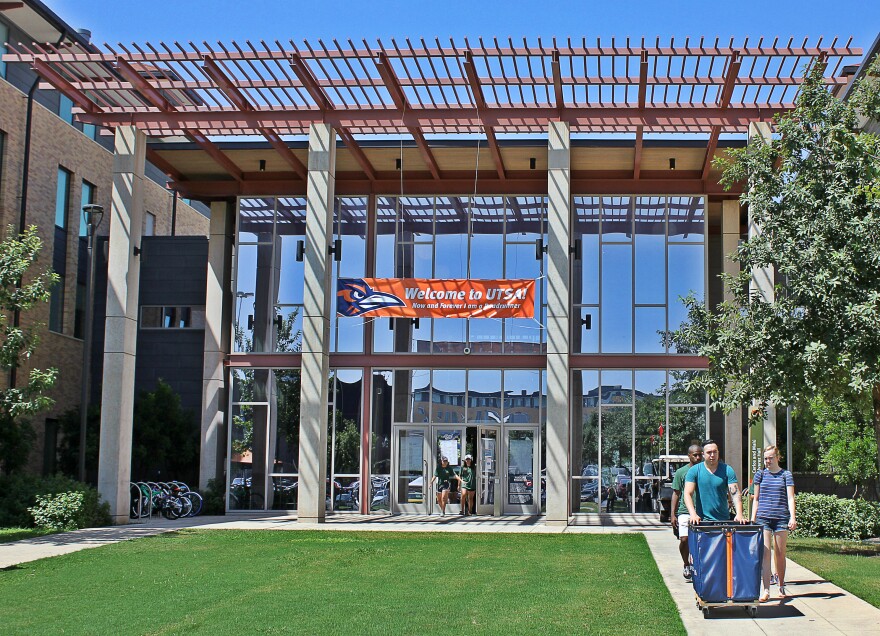More students than expected are enrolled at the University of Texas at San Antonio this fall, defying state and national predictions that economic uncertainty and a preference for the traditional college experience would cause fewer students to enroll during the coronavirus pandemic.
According to the university’s Office of Institutional Research, almost 35,000 students are enrolled at UTSA, a 6.6% increase over last fall.
“All along we were thinking we would be just above last year,” said Lynn Barnes, senior vice-provost of strategic enrollment at UTSA. “The fact that we were at 6.6% turned out really well.”
Other colleges in Texas and across the country didn’t fare as well. According to the National Student Clearinghouse, Texas colleges and universities saw a 2% drop in enrollment. Nationally, enrollment dropped 3%. State and national numbers are based on data reported to the Clearinghouse as of Sept. 24 and include statistics for about half of U.S. colleges.
Barnes said UTSA’s enrollment growth was driven by a boost in the number of new first-year students — up nearly 16% from last fall.
“Being a large city, I think a lot of students who were considering going elsewhere — out of town or even out of state — maybe decided to stay home,” Barnes said, adding that most of the additional students were from Bexar County.
UTSA launched a new free tuition program called Bold Promise this year, and it enrolled more than 900 students in its first Bold Promise cohort, about 200 more than initially projected. However, Barnes said it was unclear if the scholarship helped drive its higher first-year enrollment.
“The fact that we had a larger overall class would naturally mean that we'd probably have a larger Bold Promise (cohort),” Barnes explained.
Students are eligible for Bold Promise if they are Texas residents in the top 25% of their high school class and their family makes up to $50,500 a year.
UTSA’s big gains in first-year students are an especially stark contrast to national numbers, which show a 16.1% decrease in the number of students in college for the first time.
UTSA’s enrollment growth was also helped by an increase in graduate school enrollment, which correlates with national trends but on a larger scale. Graduate enrollment is up 3% nationally and 2.7% in Texas. The number of graduate students at UTSA, meanwhile, climbed nearly 11%.
Barnes credited the success in graduate enrollment to “some very creative work within our graduate school to help current undergraduate students have a very seamless and easy transition into graduate school.”
A new UTSA initiative called Keep Running with Us recruits graduating seniors and offers them automatic admission to master’s programs.
UTSA cut its budget and laid off more than 300 employees this summer, in part due to a projected loss in enrollment revenue. Part of the expected loss in revenue was due to an increase in need for financial aid.
In a letter to faculty and staff earlier this week, University President Taylor Eighmy said UTSA would continue to limit spending due to ongoing budget concerns caused by the pandemic. Declines in state revenue are expected to reduce the amount of state funding provided to higher education.
Enrollment at other San Antonio colleges and universities
Initial reports from the Alamo Colleges District, San Antonio’s largest institution of higher education, are less rosy than at UTSA.
The community college system’s new free tuition program, AlamoPROMISE, had to hustle to meet its goal of enrolling 3,000 students in its first cohort. In September, the San Antonio Express-News reported many Alamo Colleges students were struggling to pay enough tuition to stay enrolled.
Community college enrollment has suffered the brunt of national enrollment declines this fall, with a 22.7% drop in students enrolling in college for the first time, according to the National Student Clearinghouse.
Public four-year universities like UTSA, meanwhile, have seen relatively mild losses averaging out to a 1.4% drop in undergraduate enrollment nationwide.
Private non-profit universities like Trinity and St. Mary’s fared slightly worse, with a decline of 2%. San Antonio’s largest private non-profit, the University of the Incarnate Word, saw a 3.3% drop in enrollment this fall. UIW reported a fall enrollment of 7,915, about 250 fewer students than last year.
TPR was founded by and is supported by our community. If you value our commitment to the highest standards of responsible journalism and are able to do so, please consider making your gift of support today.







